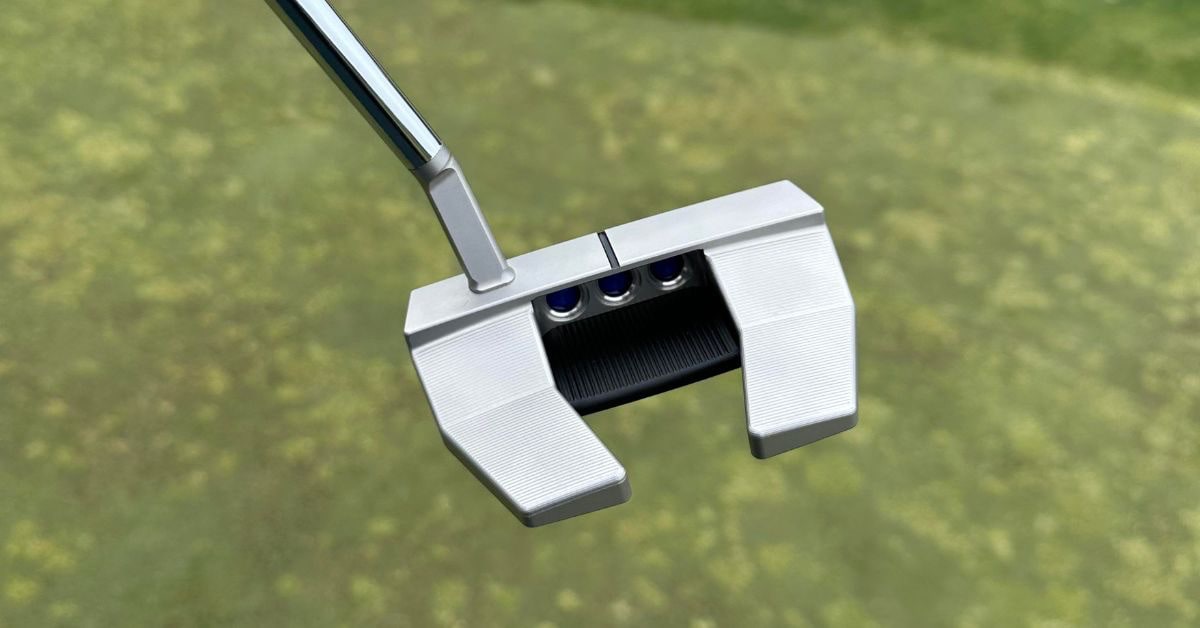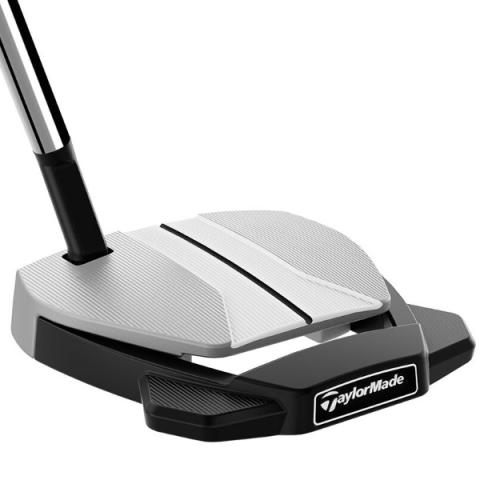Putting is — in theory — a simple task.
Roll the ball on your target line with the correct speed, and hope it drops in the hole!
Nevertheless, putters have evolved to be one of the most technical clubs in golf. With a variety of head shapes, shaft lengths, and grip types — it can be overwhelming.
When choosing a putter, you should consider the neck type. Matching up the correct neck with your stroke can unlock another level of consistency on the greens.
In this article, you’ll learn everything about the slant neck putter. Then, you can take a look at our favorite ones to buy, before deciding whether to add one to the bag.
What is a Slant Neck Putter?
With a slant neck putter, the shaft connects to the head via a single bend in the hosel. This offsets the face behind the shaft to allow the hands to sit ahead of the ball. Slant neck putters have plenty of toe hang for an arc stroke with toe release.
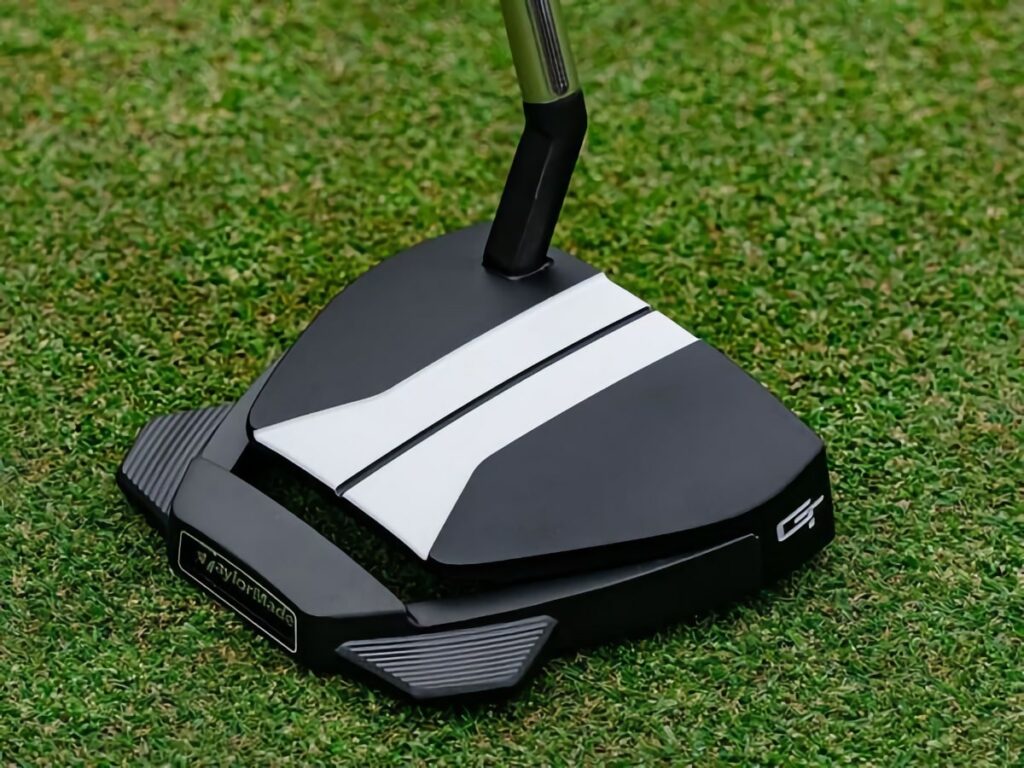
Slant neck putters have a single angle in the hosel, which links the shaft to the head.
This produces offset — when the face of the putter sits behind the line of the shaft by anywhere up to an inch. Put simply, offset allows you to have your hands positioned forward of the ball in the stroke, which squares up the face at impact.
Having said that, too much offset can often cause pulled putts. To avoid this, a slant neck putter head will almost always be designed with lots of toe hang.
So, what exactly is toe hang?
Essentially, it’s extra weight in the toe. Guerin Rife of EvnRoll, explains that with toe hang, “the putter head continues to lag, causing the putter head to remain open.”
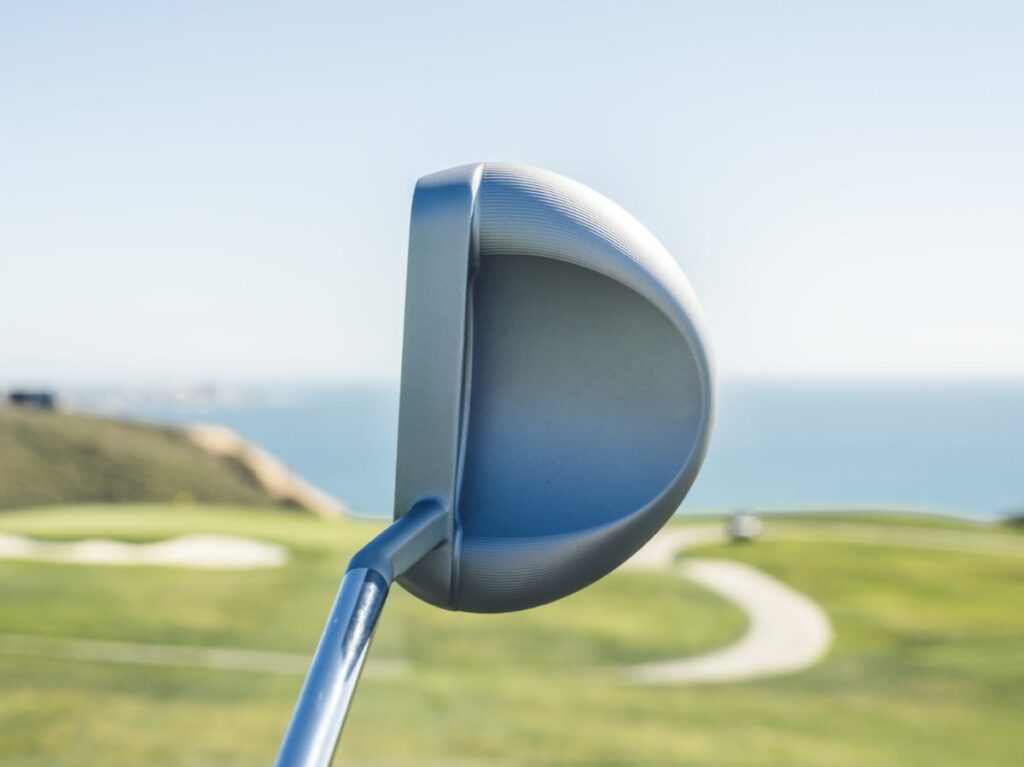
Who Is a Slant Neck Putter For?
Flow neck putters are best suited for golfers with an arc putting stroke.
Since most slant neck putters have lots of toe hang to counteract the offset, an arc stroke is required to release the toe and maintain a square face at impact.
For instance, Jon Rahm switched to an Odyssey Rossie S Putter in 2021. Moving to a slant neck putter enabled him to gain confidence in his strong arc putting stroke.
Joe Toulon, Odyssey Tour Rep, explained the reasoning behind the switch:
“The slant neck allowed him to feel the putter face rotate open during the backstroke which allowed him to feel that he could release the toe without pulling putts.”
Joe Toulon, Odyssey
Slant Neck vs Plumbers Neck
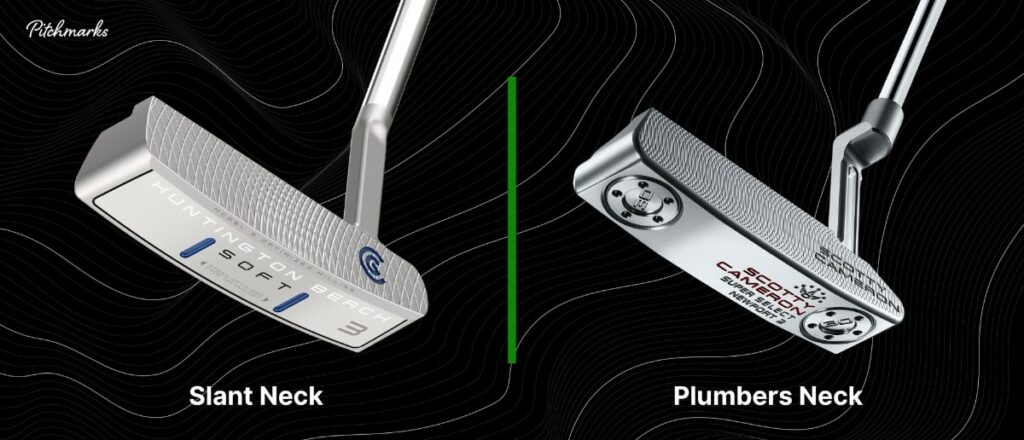
Slant neck putters and plumbers neck putters have similar amounts of offset and toe hang, as both encourage an arc stroke and plenty of toe release.
| Slant Neck | Plumbers Neck | |
| Offset | Moderate | High |
| Toe Hang | Moderate | Moderate |
| Stroke Type | Arc | Arc |
The plumbers neck putter first became popular in the 1960s, when Karsten Solheim of Ping designed the Anser Putter. It went on to become one of the most successful putter shapes in the history of golf.
While a slant neck putter has a single bend at the hosel to form offset, the plumbers neck putter has a horizontal angle formed by two sharp bends.
Ultimately, both types of hosel produce similar results. It’s more of a personal preference when choosing between the slant neck vs plumbers neck.
I use a Scotty Cameron Newport 2 with a plumbers neck hosel, but I can understand why many golfers prefer the sleek appearance of the slant neck putter type.
PRO TIP: Plumbers neck putters are best suited for players who have an arc in their putting stroke.
Slant Neck vs Flow Neck
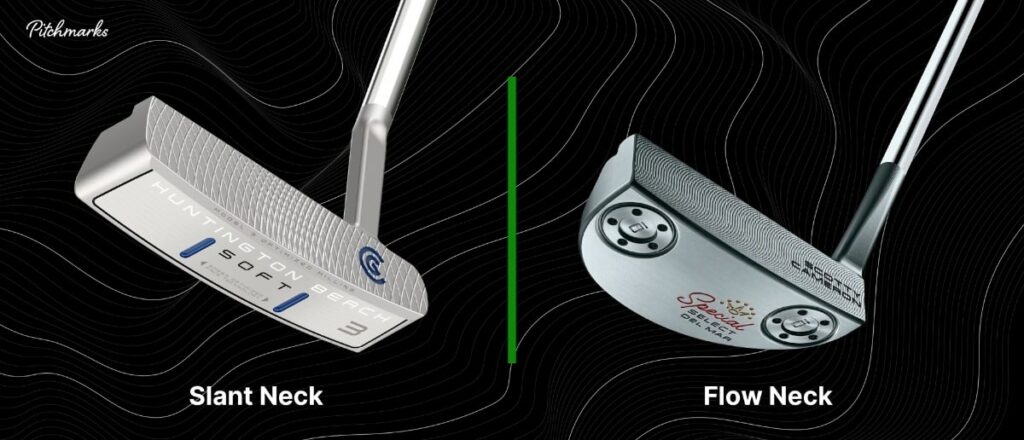
Once again, the performance is very similar between a slant neck putter and a flow neck putter. Rather than the single bend as found in slant neck hosels, the flow neck features a continuous sweeping curve to connect the shaft to the head.
| Slant Neck | Flow Neck | |
| Offset | Moderate | Moderate |
| Toe Hang | Moderate | High |
| Stroke Type | Arc | Arc |
Often, flow neck putters are equipped with slightly more offset than slant necks. So, most offer a hefty amount of toe hang to maintain a square face.
Another thing to consider is that flow neck putters are harder to manufacture. For this reason, they can often demand higher retail prices to accommodate this.
Ultimately, the differences between slant neck and flow neck putters will vary depending on the types of putters you test.
PRO TIP: Flow neck putters are best suited for players who have a pronounced arc in their putting stroke.
Slant Neck vs Single Bend
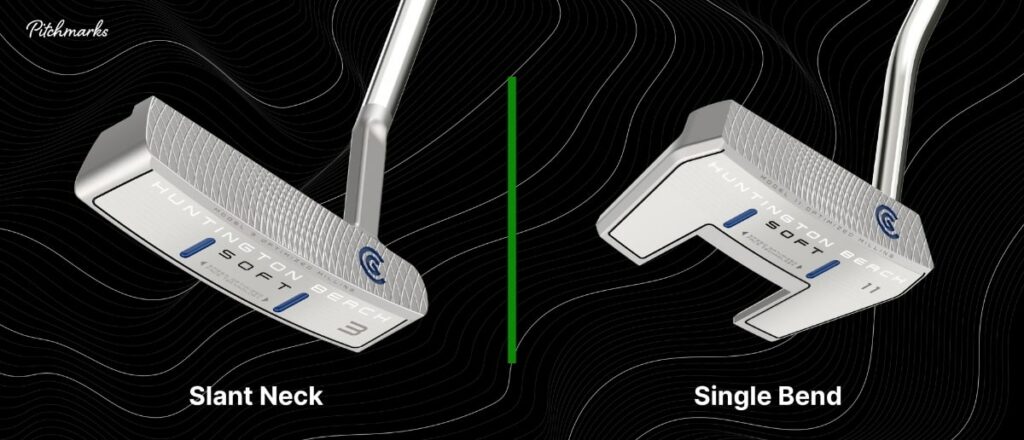
While slant neck putters technically have a “single bend” on the hosel, single bend putters have a more gradual bend that occurs on the shaft itself.
| Slant Neck | Single Bend | |
| Offset | Moderate | High |
| Toe Hang | Moderate | Zero |
| Stroke Type | Arc | Straight-back, straight-through |
Usually, single bend putters have a bend which occurs further from the head than the bend you’d find on a slant neck putter.
This allows for an unobtrusive vie of the ball, which many golfers enjoy.
However, due to the nature of the bend, single bend putters have zero toe hang and are primarily suited to those who have zero arc in their putting stroke.
Most often, single bend putters are mallets rather than blades.
PRO TIP: Single bend putters are best suited for players with a straight-back, straight-through putting stroke.
Slant Neck vs Double Bend
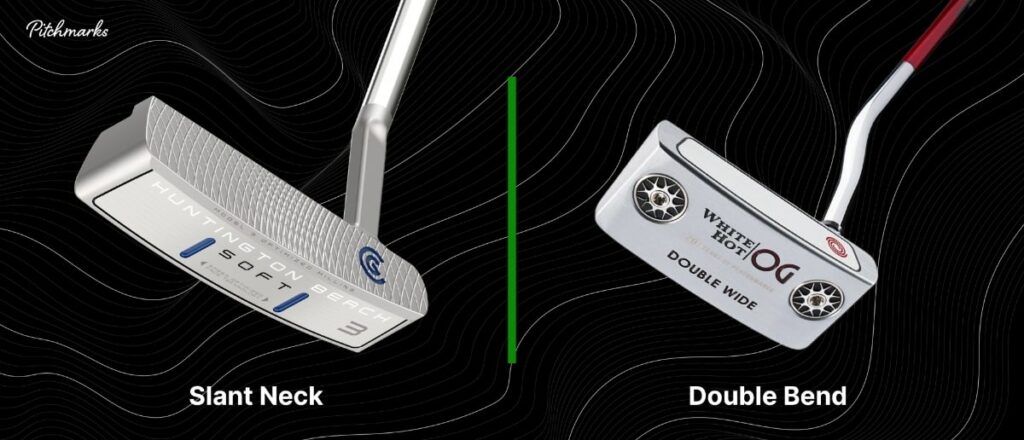
While slant neck putters have a bend that occurs at the hosel, double bend putters have two bends on the shaft itself — very similar to single bend putters.
| Slant Neck | Double Bend | |
| Offset | Moderate | High |
| Toe Hang | Moderate | Zero |
| Stroke Type | Arc | Straight-back, straight-through |
Once again, double bend putters are for those who putt without an arc in their stroke.
In my view, double bend putters can feel very alien if you’re used to putting with a more traditional blade putter equipped with a hosel — as I grew up using!
However, the straight-back, straight-through motion can be consistently repeatable if you prefer to use a mechanical-like putting action.
PRO TIP: Double bend putters are best suited for players with a straight-back, straight-through putting stroke.
Check out the video below by Golfbidder, which summarizes the various types of putter necks to help you decide which is most likely to suit your stroke:
Best Slant Neck Putters
So, by now you know precisely what characterizes a slant neck putter — along with how it compares to the other putters that are available on the market today.
Below, you’ll find three of the best slant neck putters to choose from:
TaylorMade Spider GTX Putter
An ultra-stable mallet putter for ultimate forgiveness.
The TaylorMade Spider GTX Putter offers an oversized mallet head for excellent stability and forgiveness for off-center strikes. It also provides an excellent alignment line.
Available in six finishes — silver, black, white, red, pink, and ice blue — the Spider GTX has a modern design that will suit many golfers.
Odyssey White Hot OG Rossie S Putter
White Hot is the most iconic, most played, and most decorated putter insert ever.
Used by many tour professionals and amateur golfers alike, the Odyssey White Hot collection offers a super soft feel off the face thanks to the polymer insert.
With a mid-mallet head shape, this slant neck putter is best suited for players who have an arc putting stroke with plenty of face rotation — aided by the toe hang.
Cleveland Huntington Beach Soft #3 Putter
Cleveland deliver a classic-looking putter at a fantastic price point.
The Huntington Beach Soft #3 Putter has a diamond CNC-milled face pattern to increase friction, resulting in a pure roll and a soft feel at impact.
Despite being a thin blade putter, it’s designed with “Speed Optimized Face Technology” to produce a consistent ball speed across the entire putter face.
Final Thoughts
In short, a slant neck putter is one where the hosel has a single sharp angle to link the shaft to the head. This bend offsets the putter face back from the line of the shaft.
The inherent offset allows you to keep your hands ahead of the ball during the stroke, which produces an arc with lots of toe releease assisted by plenty of toe hang.
Ultimately, I recommend you test out several putter types before settling on one. That way, you can identify which neck type and head shape works best for your stroke.

